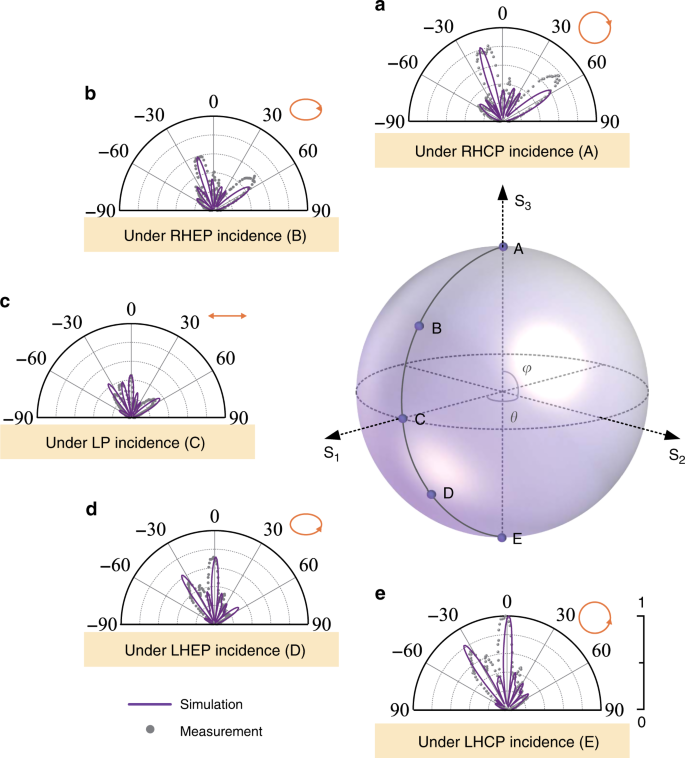The Mac
@TheMac
26 June, 01:24
Just sending you all some love.
🙏🏻❤️
🙏🏻❤️
Notice: Undefined index: tg1tga_access in /home/admin/www/anonup.com/themes/default/apps/timeline/post.phtml on line 396
In response The Mac to his Publication
Notice: Undefined index: tg1tga_access in /home/admin/www/anonup.com/themes/default/apps/timeline/post.phtml on line 396
The Mac
@TheMac
26 June, 02:14
In response yo. lisa to her Publication
❤️👈🏻
Notice: Undefined index: tg1tga_access in /home/admin/www/anonup.com/themes/default/apps/timeline/post.phtml on line 396
The Mac
@TheMac
26 June, 02:20
In response The Mac to his Publication
a Under the RHCP incidence, two main output lobes located at −16° and 58° carry co-polarization and cross-polarization respectively. b Under the RHEP incidence, four lobes appears at −35°, −16°, 0°, and 58° for L–L, R–R, L–R, and R–L channels respectively. c Under the LP incidence, four lobes are exhibited at −35°, −16°, 0°, and 58°. d Under the LHEP incidence, four lobes are shown at −35°, −16°, 0°, and 58°, which is opposite to that of RHEP incidence. e Under the LHCP incidence, only two main output lobes located at −35° and 0° carry co-polarization and cross-polarization, respectively.
Notice: Undefined index: tg1tga_access in /home/admin/www/anonup.com/themes/default/apps/timeline/post.phtml on line 396
The Mac
@TheMac
26 June, 02:23
In response The Mac to his Publication
polarization (n.)
1812, "state of having different properties on different sides," from polarize + -ation, and in part from French polarisation, noun of action from polariser. Figuratively from 1871; of social and political groups, "accentuation of differences," from 1945.
1812, "state of having different properties on different sides," from polarize + -ation, and in part from French polarisation, noun of action from polariser. Figuratively from 1871; of social and political groups, "accentuation of differences," from 1945.
Notice: Undefined index: tg1tga_access in /home/admin/www/anonup.com/themes/default/apps/timeline/post.phtml on line 396
The Mac
@TheMac
26 June, 02:25
In response The Mac to his Publication
polarization
/pəʊlərʌɪˈzeɪʃ(ə)n/
noun: polarisation
1.
division into two sharply contrasting groups or sets of opinions or beliefs.
"the polarization of society between rich and poor"
2.
PHYSICS
the action of restricting the vibrations of a transverse wave, especially light, wholly or partially to one direction.
"changes in polarization of light passing through the atmosphere"
3.
PHYSICS
the action of causing something to acquire polarity.
"probes need to warm up to ensure proper polarization of the electrodes"
/pəʊlərʌɪˈzeɪʃ(ə)n/
noun: polarisation
1.
division into two sharply contrasting groups or sets of opinions or beliefs.
"the polarization of society between rich and poor"
2.
PHYSICS
the action of restricting the vibrations of a transverse wave, especially light, wholly or partially to one direction.
"changes in polarization of light passing through the atmosphere"
3.
PHYSICS
the action of causing something to acquire polarity.
"probes need to warm up to ensure proper polarization of the electrodes"
Notice: Undefined index: tg1tga_access in /home/admin/www/anonup.com/themes/default/apps/timeline/post.phtml on line 396
The electrode, or lead, is a thin, insulated wire inserted through a small opening in the skull and implanted into a specific brain area. The extension wire is also insulated and passed under the skin of the head, neck and shoulder, connecting the electrode to the internal pulse generator (IPG).
02:28 PM - Jun 26, 2021
In response The Mac to his Publication
Only people mentioned by TheMac in this post can reply
The Mac
@TheMac
26 June, 02:29
In response The Mac to his Publication
Nanoelectrochemistry is a branch of electrochemistry that investigates the electrical and electrochemical properties of materials at the nanometer size regime. Nanoelectrochemistry plays significant role in the fabrication of various sensors, and devices for detecting molecules at very low concentrations.
Notice: Undefined index: tg1tga_access in /home/admin/www/anonup.com/themes/default/apps/timeline/post.phtml on line 396
The Mac
@TheMac
26 June, 02:30
In response The Mac to his Publication
Two transport mechanisms are fundamental for nanoelectrochemistry: electron transfer and mass transport. The formulation of theoretical models allows to understand the role of the different species involved in the electrochemical reactions.
The electron transfer between the reactant and the nanoelectrode can be explained by the combination of various theories based on the Marcus theory.
Mass transport, that is the diffusion of the reactant molecules from the electrolyte bulk to the nanoelectrode, is influenced by the formation of a double electric layer at the electrode/electrolyte interface. At the nanoscale it is necessary to theorize a dynamic double electric layer which takes into account an overlap of the Stern layer and the diffuse layer.
The electron transfer between the reactant and the nanoelectrode can be explained by the combination of various theories based on the Marcus theory.
Mass transport, that is the diffusion of the reactant molecules from the electrolyte bulk to the nanoelectrode, is influenced by the formation of a double electric layer at the electrode/electrolyte interface. At the nanoscale it is necessary to theorize a dynamic double electric layer which takes into account an overlap of the Stern layer and the diffuse layer.
Notice: Undefined index: tg1tga_access in /home/admin/www/anonup.com/themes/default/apps/timeline/post.phtml on line 396


